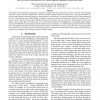2047 search results - page 308 / 410 » The limits of speech recognition |
MM
2005
ACM
14 years 2 months ago
2005
ACM
Most work in human activity recognition is limited to relatively simple behaviors like sitting down, standing up or other dramatic posture changes. Very little has been achieved i...
ACII
2007
Springer
14 years 1 months ago
2007
Springer
The recognition of affective human communication may be used to provide developers with a rich source of information for creating systems that are capable of interacting well with ...
COLING
1996
13 years 10 months ago
1996
The development of natural language proccssing (NLP) systems that perform machine translation (MT) and information retrieval (IR) has highlighted the need for the automatic recogn...
AUTOMOTIVEUI
2009
ACM
14 years 3 months ago
2009
ACM
Auditory display research for driving has mainly focused on collision warning signals, and recent studies on auditory invehicle information presentation have examined only a limit...
LREC
2010
13 years 10 months ago
2010
The collection and transcription of speech data is typically an expensive and time-consuming task. Voice over IP and cloud computing are poised to greatly reduce this impediment t...

